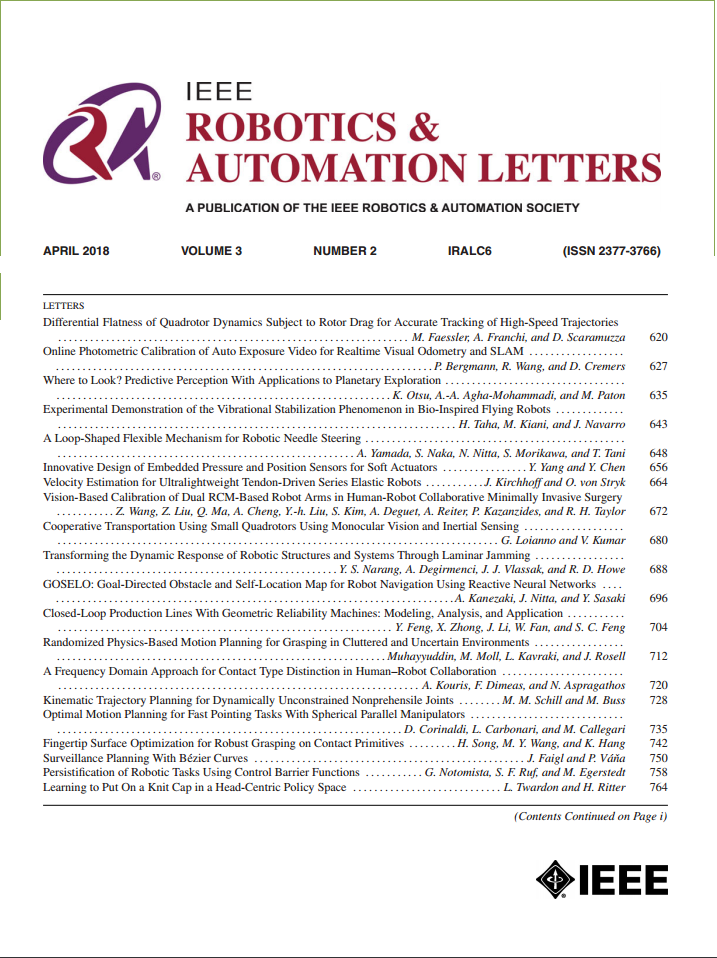基于离散小波变换的多地形步行辅助鲁棒步态相位估计
IF 4.6
2区 计算机科学
Q2 ROBOTICS
引用次数: 0
摘要
步态相位检测是实现下肢外骨骼个性化辅助功能的关键。一种常用的步态相位估计方法是自适应振荡器,它在周期性步态中表现良好。然而,这些方法在非周期步态周期下的步态相位估计失败。虽然已经提出了一些改进的多地形下步态相位估计方法,但这些方法通常需要对数据集进行训练,并且估计精度高度依赖于所收集的数据集。为了实现准确稳定的步态相位识别,提出了一种不需要数据集训练的步态相位估计方法。该方法将离散小波变换(DWT)与自适应振子(ao)相结合,可以在线识别非周期突变,并在适当的时候对振子进行复位,避免自适应振子受到突变信号时出现发散现象。该方法利用惯性测量单元(IMU)传感器测量髋部倾角,然后对测量数据进行离散小波变换,检测髋部最大弯曲角(MFA)和非周期突变。最后通过改进的自适应振荡器估计步态相位。在不同的行走条件下,对6名受试者进行了不同速度的地面行走测试,结果表明,该方法可以鲁棒地估计多种地形下的步态相位。该方法在辅助行走的髋关节外骨骼上进行了演示。本文章由计算机程序翻译,如有差异,请以英文原文为准。
Robust Gait Phase Estimation With Discrete Wavelet Transform for Walking Assistance on Multiple Terrains
Gait phase detection is crucial to realize personalized assistive functions of lower limb exoskeletons. A common method of gait phase estimation is the adaptive oscillator, which performs well in periodic gaits. However, these types of methods fail in gait phase estimation under aperiodic gait cycles. Although some modified methods have been proposed for gait phase estimation under multiple terrains, they usually require dataset training, and the estimation accuracy is highly dependent on the collected dataset. To realize accurate and stable recognition of gait phase, a novel gait phase estimation method is proposed to estimate the gait phase without dataset training. This method, by incorporating discrete wavelet transform (DWT) with adaptive oscillators (AOs), can identify non-periodic mutations online and reset the oscillator at an appropriate time to avoid the divergence phenomenon when the adaptive oscillator is subjected to mutation signals. In this proposed method, the hip angle is measured by an inertial measurement unit (IMU) sensor and the measured data is then processed using discrete wavelet transform to detect the maximum hip flexion angle (MFA) and non-periodic mutations. The gait phase is finally estimated by a modified adaptive oscillator. Ground walking tests with a variety of speeds by six subjects were conducted under different walking conditions and the results show that the new method works robustly for gait phase estimation under multiple terrains. The method is demonstrated on a hip exoskeleton in walking assistance.
求助全文
通过发布文献求助,成功后即可免费获取论文全文。
去求助
来源期刊

IEEE Robotics and Automation Letters
Computer Science-Computer Science Applications
CiteScore
9.60
自引率
15.40%
发文量
1428
期刊介绍:
The scope of this journal is to publish peer-reviewed articles that provide a timely and concise account of innovative research ideas and application results, reporting significant theoretical findings and application case studies in areas of robotics and automation.
 求助内容:
求助内容: 应助结果提醒方式:
应助结果提醒方式:


